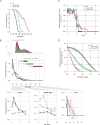How a Mutation that Slows Aging Can Also Disproportionately Extend End-of-Life Decrepitude
- PMID: 28423308
- PMCID: PMC5526670
- DOI: 10.1016/j.celrep.2017.03.062
How a Mutation that Slows Aging Can Also Disproportionately Extend End-of-Life Decrepitude
Abstract
The goal of aging research is to extend healthy, active life. For decades, C. elegans daf-2 insulin/insulin-like growth factor 1 (IGF-1) receptor mutants have served as a model for extended lifespan and youthfulness. However, a recent report suggested that their longevity is associated with an undesirable phenotype: a disproportionately long period of decrepitude at the end of life. In the human population, such an outcome would be a burden to society, bringing into question the relevance of daf-2 mutants as a model for life extension. However, here we report that, following an extended period of movement, daf-2 mutants survive longer in a decrepit state because of a beneficial trait: they are resistant to colonization of the digestive tract by dietary bacteria, a condition that leads to premature death in the wild-type and prevents their manifestation of decrepitude. If bacterial colonization is prevented, then daf-2 mutants lead both chronologically and proportionately healthier lives relative to the wild-type.
Keywords: IGF-1; aging; daf-2; healthspan; lifespan; mortality; pathogenesis.
Copyright © 2017 The Author(s). Published by Elsevier Inc. All rights reserved.
Figures





References
-
- Bartke A. Insulin and aging. Cell cycle. 2008;7:3338–3343. - PubMed
-
- Centers for Medicare & Medicaid Services. NHE fact sheet. Baltimore: p. 2015.
MeSH terms
Substances
Grants and funding
LinkOut - more resources
Full Text Sources
Other Literature Sources
Medical
Miscellaneous

